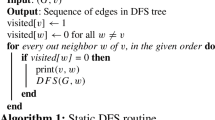Abstract
The problem of finding a maximum clique is a fundamental problem for undirected graphs, and it is natural to ask whether there are analogous computational problems for directed graphs. Such a problem is that of finding a maximum transitive subtournament in a directed graph. A tournament is an orientation of a complete graph; it is transitive if the occurrence of the arcs \(xy\) and \(yz\) implies the occurrence of \(xz\). Searching for a maximum transitive subtournament in a directed graph \(D\) is equivalent to searching for a maximum induced acyclic subgraph in the complement of \(D\), which in turn is computationally equivalent to searching for a minimum feedback vertex set in the complement of \(D\). This paper discusses two backtrack algorithms and a Russian doll search algorithm for finding a maximum transitive subtournament, and reports experimental results of their performance.

Similar content being viewed by others
References
Alon N (1998) On the capacity of digraphs. Eur J Combin 19:1–5
Bang-Jensen J, Gutin G (2001) Digraphs: theory, algorithms and applications. Springer, London
Berghammer R, Fronk A (2006) Exact computation of minimum feedback vertex sets with relational algebra. Fund Inform 70:301–316
Bomze IM, Budinich M, Pardalos PM, Pelillo M (1999) The maximum clique problem. In: Du D-Z, Pardalos PM (eds) Handbook of combinatorial optimization, supplement vol A. Kluwer, Dordrecht, pp 1–74
Brazdil PB, Soares C (2000) A comparison of ranking methods for classification algorithm selection. In: López de Mántanas R, Plaza E (eds) Machine learning: ECML 2000, LNCS vol 1810. Springer, Berlin, pp 63–74
Butenko S, Wilhelm WE (2006) Clique-detection models in computational biochemistry and genomics. Eur J Oper Res 173:1–17
Carraghan R, Pardalos PM (1990) An exact algorithm for the maximum clique problem. Oper Res Lett 9:375–382
Chakradhar ST, Balakrishnan A, Agrawal VD (1995) An exact algorithm for selecting partial scan flip-flops. J Electron Test Theory Appl 7:83–93
Cong J, Smith M (1993) A parallel bottom-up clustering algorithm with applications to circuit partitioning in VLSI design. In: Proceedings of the 30th international design automation conference. ACM, New York, pp 755–760
Dechter R (2003) Constraint processing. Morgan Kaufmann, San Francisco
Funke M, Reinelt G (1996) A polyhedral approach to the feedback vertex set problem. In: Cunningham WH, McCormick ST, Queyranne M (eds) Integer programming and combinatorial optimization, LNCS vol 1084. Springer, Berlin, pp 445–459
Garey MR, Johnson DS (1979) Computers and intractability: a guide to the theory of NP-completeness. W. H Freeman, San Francisco
Gargano L, Körner J, Vaccaro U (1992) Qualitative independence and Sperner problems for directed graphs. J Combin Theory Ser A 61:173–192
Karp RM (1972) Reducibility among combinatorial problems. In: Miller RE, Thatcher JW (eds) Complexity of computer computations. Plenum, New York, pp 85–103
Kiviluoto L, Östergård PRJ, Vaskelainen VP (2009) Sperner capacity of small digraphs. Adv Math Commun 3:125–133
Körner J, Pilotto C, Simonyi G (2005) Local chromatic number and Sperner capacity. J Combin Theory Ser B 95:101–117
Lam CWH, Thiel LH, Swiercz S (1988) A computer search for a projective plane of order 10. In: Deza MM, Frankl P, Rosenberg IG (eds) Algebraic, extremal and metric combinatorics. Cambridge University Press, Cambridge, pp 155–165
Lin H-M, Jou J-Y (2000) On computing the minimum feedback vertex set of a directed graph by contraction operations. IEEE Trans Comput-Aided Design Integr Circuits Syst 19:295–307
Lloyd EL, Soffa ML (1988) On locating minimum feedback vertex sets. J Comput Syst Sci 37:292–311
McGeoch CC (2007) Experimental algorithmics. Commun ACM 50(11):27–31
Neumann-Lara V (1982) The dichromatic number of a digraph. J Combin Theory Ser B 33:265–270
Orenstein T, Kohavi Z, Pomeranz I (1995) An optimal algorithm for cycle breaking in directed graphs. J Electron Test Theory Appl 7:71–81
Östergård PRJ (2002) A fast algorithm for the maximum clique problem. Discrete Appl Math 120:197–207
Östergård PRJ, Vaskelainen VP (2011) Russian doll search for the Steiner triple covering problem. Optim Lett 5:631–638
Pardalos PM, Xue J (1994) The maximum clique problem. J Global Optim 4:301–328
Rhodes N, Willett P, Calvet A, Dunbar JB, Humblet C (2003) CLIP: similarity searching of 3D databases using clique detection. J Chem Inform Comput Sci 43:443–448
Sali A, Simonyi G (1999) Orientations of self-complementary graphs and the relation of Sperner and Shannon capacities. Eur J Combin 20:93–99
Shannon CE (1956) The zero-error capacity of a noisy channel. IRE Trans Inform Theory 2:8–19
Smith GW Jr, Walford RB (1975) The identification of a minimal feedback vertex set of a directed graph. IEEE Trans Circuits Syst 22:9–14
Thiel LH, Lam CWH, Swiercz S (1987) Using a CRAY-1 to perform backtrack search. In: Kartashev LP, Kartashev SI (eds) Supercomputing ’87: supercomputer design, performance evaluation and performance education, vol 3. International Supercomputing Institute, St. Petersburg, FL, pp 92–99
Verfaillie G, Lemaître M, Schiex T (1996) Russian doll search for solving constraint optimization problems. In: Proceedings of the 13th national conference on artificial intelligence (AAAI-96). AAAI Press, Menlo Park, pp 181–187
Acknowledgments
The authors thank Brendan McKay for useful discussions and the referees for valuable comments. L. Kiviluoto was supported by the Academy of Finland, Grant No. 100500. P. R. J. Östergård was supported in part by the Academy of Finland, Grants No. 107493, 110196, 130142, and 132122. V. P. Vaskelainen was supported by the Academy of Finland, Grant No. 107493.
Author information
Authors and Affiliations
Corresponding author
Rights and permissions
About this article
Cite this article
Kiviluoto, L., Östergård, P.R.J. & Vaskelainen, V.P. Algorithms for finding maximum transitive subtournaments. J Comb Optim 31, 802–814 (2016). https://doi.org/10.1007/s10878-014-9788-z
Published:
Issue Date:
DOI: https://doi.org/10.1007/s10878-014-9788-z




